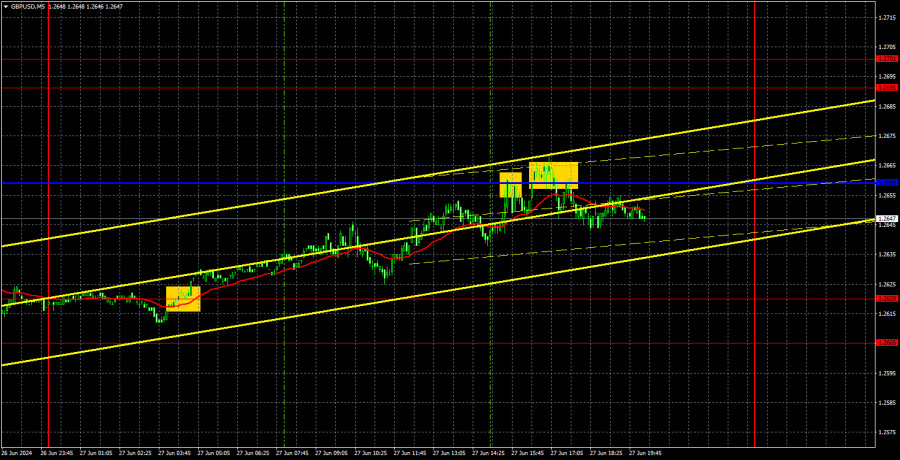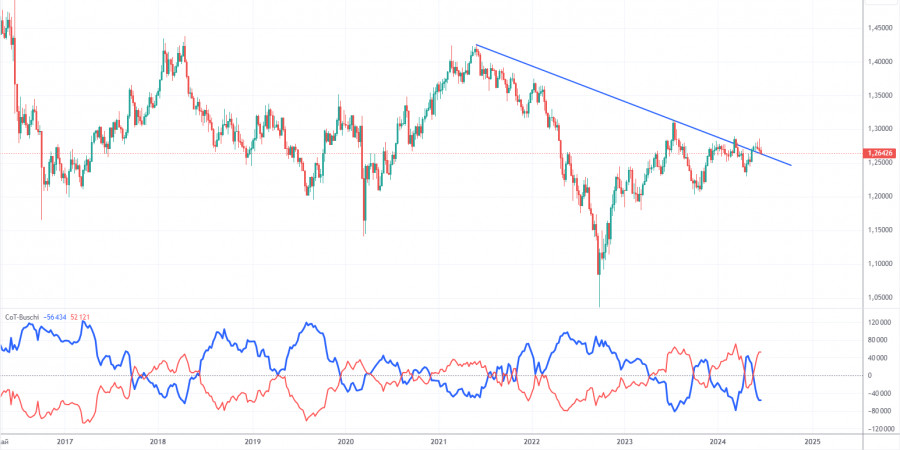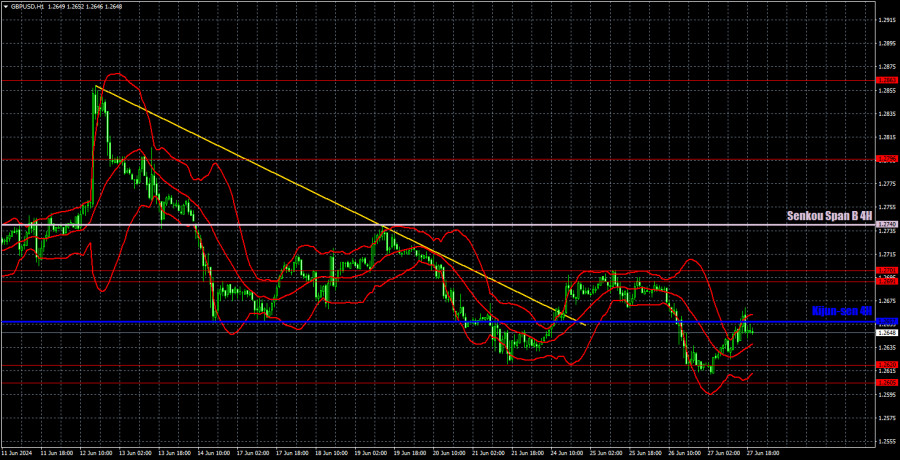Analysis of GBP/USD 5M

GBP/USD rebounded from the 1.2620 level for the second time, and started a corrective move again. As we have previously mentioned, consolidating above the descending trend line doesn't mean anything important right now. The pair is going through a flat phase just like the EUR/USD. The only difference is that the pound has been flat for less than two weeks and it still has a slight downward slope. However, the price cannot break through the nearest support area of 1.2605-1.2620. There was no fundamental and macroeconomic background for most of the week. Therefore, the price is simply bouncing from the nearest levels and areas.
The first notable reports of the week were released yesterday, which supported the GBP/USD bulls. We can't exactly say that the US reports were absolutely weak, but let's just say they weren't strong enough either. The US economy grew by 1.4% in the first quarter, as forecasted, but the volume of orders for durable goods over the last two months increased weaker than expected. Most likely, it was this report, not the GDP data, that triggered the dollar's decline on Thursday. However, it was not strong and it didn't last long.
A good buy signal was formed on Thursday, but it happened during the Asian trading session. The price rebounded from the 1.2605-1.2620 area, after which it managed to rise to the critical line. We have already mentioned that the Kijun-sen line doesn't have any power in flat conditions, but investors could close trades near this area if they wanted to. Traders could have opened a long position at the start of the European session, as by that time the price had only moved 5 pips from the point where the signal was formed. The profit from the deal was about 25 pips. This is an excellent result given the overall volatility of around 50 pips.
COT report:

COT reports on the British pound show that the sentiment of commercial traders has frequently changed in recent years. The red and blue lines, which represent the net positions of commercial and non-commercial traders, constantly intersect and generally remain close to the zero mark. According to the latest report on the British pound, the non-commercial group opened 8,100 buy contracts and closed 700 short ones. As a result, the net position of non-commercial traders increased by 8,800 contracts over the week, which is quite significant for the pound. Thus, sellers failed to seize the initiative at the most critical moment.
The fundamental background still does not provide a basis for long-term purchases of the pound sterling, and the currency has a good chance to resume the global downward trend. However, the price has already breached the trend line on the 24-hour timeframe at least twice. The level of 1.2765 is currently preventing the pound from rising further.
The non-commercial group currently has a total of 110,300 buy contracts and 58,200 sell contracts. The bulls have taken the initiative, but aside from the COT reports, there is nothing else that suggests a potential rise in the GBP/USD pair.
Analysis of GBP/USD 1H

On the 1H chart, GBP/USD is struggling to extend its downward movement but so far it has been unable to break through the 1.2605-1.2620 area. A new rebound from this area has pushed the pair to correct upwards, and the price surged towards the 1.2691-1.2701 area. We insist that the pound fall, but it is quite naive to expect that a pair, which has shown unreasonable growth for more than six months, will suddenly start falling every day. We expect a very slow decline.
As of June 28, we highlight the following important levels: 1.2215, 1.2269, 1.2349, 1.2429-1.2445, 1.2516, 1.2605-1.2620, 1.2691-1.2701, 1.2796, 1.2863, 1.2981-1.2987. The Senkou Span B (1.2740) and Kijun-sen (1.2657) lines can also serve as sources of signals. Don't forget to set a Stop Loss to breakeven if the price has moved in the intended direction by 20 pips. The Ichimoku indicator lines may move during the day, so this should be taken into account when determining trading signals.
On Friday, the UK will release its first and only notable report for the week – the third estimate of GDP numbers for Q1. We don't consider this an important report, and its value is unlikely to differ from the second estimate – 0.6%. The US docket will feature secondary data. We can highlight the PCE index and the consumer sentiment index from the University of Michigan.
Description of the chart:
Support and resistance levels are thick red lines near which the trend may end. They do not provide trading signals;
The Kijun-sen and Senkou Span B lines are the lines of the Ichimoku indicator, plotted to the 1H timeframe from the 4H one. They provide trading signals;
Extreme levels are thin red lines from which the price bounced earlier. They provide trading signals;
Yellow lines are trend lines, trend channels, and any other technical patterns;
Indicator 1 on the COT charts is the net position size for each category of traders;
The material has been provided by InstaForex Company - www.instaforex.comfrom Forex analysis review https://ift.tt/ldtgxo0
via IFTTT
